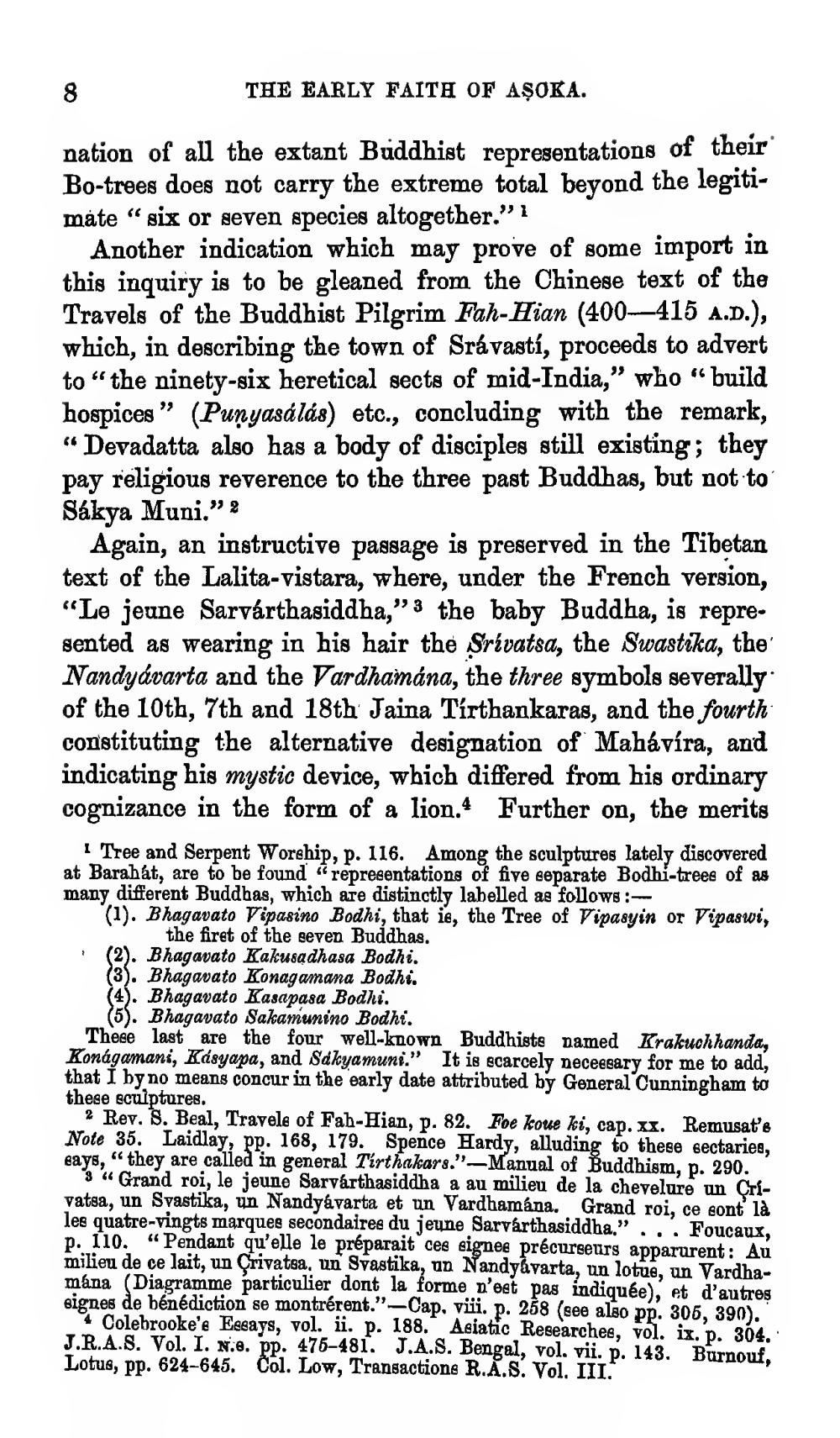________________
THE EARLY FAITH OF ASOKA.
nation of all the extant Buddhist representations of their Bo-trees does not carry the extreme total beyond the legitimate "six or seven species altogether."
"" 1
Another indication which may prove of some import in this inquiry is to be gleaned from the Chinese text of the Travels of the Buddhist Pilgrim Fah-Hian (400-415 a.d.), which, in describing the town of Srávastí, proceeds to advert to "the ninety-six heretical sects of mid-India," who "build hospices" (Punyasálás) etc., concluding with the remark, "Devadatta also has a body of disciples still existing; they pay religious reverence to the three past Buddhas, but not to Sákya Muni." 2
8
Again, an instructive passage is preserved in the Tibetan text of the Lalita-vistara, where, under the French version, "Le jeune Sarvárthasiddha,” ,"3 the baby Buddha, is represented as wearing in his hair the Srivatsa, the Swastika, the Nandyávarta and the Vardhamána, the three symbols severally of the 10th, 7th and 18th Jaina Tirthankaras, and the fourth constituting the alternative designation of Mahávíra, and indicating his mystic device, which differed from his ordinary cognizance in the form of a lion. Further on, the merits
1 Tree and Serpent Worship, p. 116. Among the sculptures lately discovered at Barahat, are to be found "representations of five separate Bodhi-trees of as many different Buddhas, which are distinctly labelled as follows:
(1). Bhagavato Vipasino Bodhi, that is, the Tree of Fipasyin or Vipaswi,
the firet of the seven Buddhas. (2). Bhagavato Kakusadhasa Bodhi. (3). Bhagavato Konagamana Bodhi. (4). Bhagavato Kasapasa Bodhi. (5). Bhagavato Sakamunino Bodhi.
These last are the four well-known Buddhists named Krakuchhanda, Konágamani, Kasyapa, and Sakyamuni." It is scarcely necessary for me to add, that I by no means concur in the early date attributed by General Cunningham to these sculptures.
2 Rev. S. Beal, Travele of Fah-Hian, p. 82. Foe koue ki, cap. xx. Remusat's Note 35. Laidlay, pp. 168, 179. Spence Hardy, alluding to these sectaries, says, "they are called in general Tirthakars."-Manual of Buddhism, p. 290.
"Grand roi, le jeune Sarvárthasiddha a au milieu de la chevelure un Crívatsa, un Svastika, un Nandyávarta et un Vardhamana. Grand roi, ce sont là les quatre-vingts marques secondaires du jeune Sarvárthasiddha." p. 110. "Pendant qu'elle le préparait ces signee précurseurs apparurent: Au Foucaux, milieu de ce lait, un Crivatsa, un Svastika, un Nandyavarta, un lotue, un Vardhamana (Diagramme particulier dont la forme n'est pas indiquée), et d'autres signes de bénédiction se montrérent."-Cap. viii. p. 258 (see also pp. 305, 390).
Colebrooke's Essays, vol. ii. p. 188. Asiatic Researches, vol. ix. p. 304. J.R.A.S. Vol. I. N.e. pp. 475-481. J.A.S. Bengal, vol. vii. p. 143. Burnouf, Lotus, pp. 624-645. Col. Low, Transactions R.A.S. Vol. III.
2




